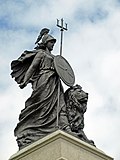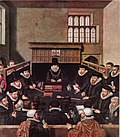Elizabethan era
Elizabethan era
The Elizabethan era refers to the period in English history marked by the reign of Queen Elizabeth I, from 1558 to 1603. This epoch is often considered a golden age in English history, characterized by flourishing English literature, notable explorations, and the emergence of the Protestant Reformation in England.
Background[edit]
The era was preceded by the Tudor period, initiated by the ascension of Henry VII to the English throne in 1485, and was succeeded by the Jacobean era, with the reign of James I starting in 1603. The Elizabethan era is particularly noted for the stability it brought to England after the tumultuous periods of the Wars of the Roses and the reign of Henry VIII, who is well-known for his six marriages and the establishment of the Church of England.
Politics and Religion[edit]
The political landscape of the Elizabethan era was dominated by the religious transformations that took place. Elizabeth I, a Protestant, established the Elizabethan Religious Settlement which declared the Church of England as the country's primary church, leading to tensions with Catholic powers in Europe, particularly Spain. The Spanish Armada's defeat in 1588 under Elizabeth's reign was a significant event, marking the decline of Spain's naval dominance and the rise of England as a major sea power.
Society and Economy[edit]
Elizabethan society was hierarchical, with the monarch at the top followed by the nobility, gentry, merchants, yeomen, and laborers. This period saw the beginning of English colonial ventures, including the establishment of the East India Company in 1600, which laid the groundwork for the British Empire. Economically, the era experienced the expansion of commerce and the emergence of a more capitalist economy.
Culture[edit]
The Elizabethan era is perhaps best known for its contributions to English literature, with William Shakespeare, Christopher Marlowe, and Ben Jonson being among the most notable playwrights of the time. The era also saw advancements in science and technology, with figures like John Dee and Francis Bacon contributing to the early development of scientific methods.
Legacy[edit]
The Elizabethan era left a lasting legacy on English culture, politics, and society. Its contributions to literature, exploration, and the arts continue to be celebrated, and the period is often idealized for its perceived harmony and prosperity.
Elizabethan_era[edit]
-
Queen Elizabeth I by George Gower
-
Britannia Statue
-
Elizabeth succession allegory
-
Cecil Court of Wards
-
English Ships and the Spanish Armada, August 1588
-
Sir Francis Drake by Marcus Gheeraerts
-
Copperplate map of St Paul's
-
Francis Bacon
Ad. Transform your life with W8MD's Budget GLP-1 injections from $75


W8MD offers a medical weight loss program to lose weight in Philadelphia. Our physician-supervised medical weight loss provides:
- Weight loss injections in NYC (generic and brand names):
- Zepbound / Mounjaro, Wegovy / Ozempic, Saxenda
- Most insurances accepted or discounted self-pay rates. We will obtain insurance prior authorizations if needed.
- Generic GLP1 weight loss injections from $75 for the starting dose.
- Also offer prescription weight loss medications including Phentermine, Qsymia, Diethylpropion, Contrave etc.
NYC weight loss doctor appointmentsNYC weight loss doctor appointments
Start your NYC weight loss journey today at our NYC medical weight loss and Philadelphia medical weight loss clinics.
- Call 718-946-5500 to lose weight in NYC or for medical weight loss in Philadelphia 215-676-2334.
- Tags:NYC medical weight loss, Philadelphia lose weight Zepbound NYC, Budget GLP1 weight loss injections, Wegovy Philadelphia, Wegovy NYC, Philadelphia medical weight loss, Brookly weight loss and Wegovy NYC
|
WikiMD's Wellness Encyclopedia |
| Let Food Be Thy Medicine Medicine Thy Food - Hippocrates |
Medical Disclaimer: WikiMD is not a substitute for professional medical advice. The information on WikiMD is provided as an information resource only, may be incorrect, outdated or misleading, and is not to be used or relied on for any diagnostic or treatment purposes. Please consult your health care provider before making any healthcare decisions or for guidance about a specific medical condition. WikiMD expressly disclaims responsibility, and shall have no liability, for any damages, loss, injury, or liability whatsoever suffered as a result of your reliance on the information contained in this site. By visiting this site you agree to the foregoing terms and conditions, which may from time to time be changed or supplemented by WikiMD. If you do not agree to the foregoing terms and conditions, you should not enter or use this site. See full disclaimer.
Credits:Most images are courtesy of Wikimedia commons, and templates, categories Wikipedia, licensed under CC BY SA or similar.
Translate this page: - East Asian
中文,
日本,
한국어,
South Asian
हिन्दी,
தமிழ்,
తెలుగు,
Urdu,
ಕನ್ನಡ,
Southeast Asian
Indonesian,
Vietnamese,
Thai,
မြန်မာဘာသာ,
বাংলা
European
español,
Deutsch,
français,
Greek,
português do Brasil,
polski,
română,
русский,
Nederlands,
norsk,
svenska,
suomi,
Italian
Middle Eastern & African
عربى,
Turkish,
Persian,
Hebrew,
Afrikaans,
isiZulu,
Kiswahili,
Other
Bulgarian,
Hungarian,
Czech,
Swedish,
മലയാളം,
मराठी,
ਪੰਜਾਬੀ,
ગુજરાતી,
Portuguese,
Ukrainian








